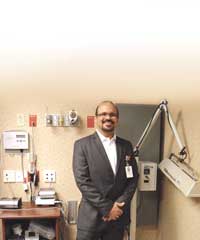Smarter, Stronger, Smaller Implantable Defibrillators Revolutionize Cardiac Medicine As They Gain Acceptance
Implantable defibrillators aren’t a new concept in the medical world, but like any technologically advanced surgical procedure, they have taken some time to be viewed less like a surgical fad and more like time-tested, effective science.
As implantable cardioverter defibrillators (ICDs) are gradually accepted and understood by the American public, more health care systems across the country are adding the procedure of implanting the devices to their surgical repertoires.
Nationally, ICDs gained some attention when Vice President Dick Cheney became an inadvertent poster child for the devices. Locally, Baystate Medical Center offers the surgery, and Mercy Medical Center recently began implanting the defibrillators in October.
Further, the technology associated with ICDs has improved along with their notoriety. Dr. James Kirchhoffer, chief of Cardiology at Baystate Medical Center, said ICDs have been around since the 1980s, but in the early years of implantation, the devices were significantly larger, and could not function with the alacrity that they do today.
“In the past 20 years, ICDs have shrunk ridiculously,” said Kirchhoffer. “They are much smaller, much smarter, and have seen significant strides in technology.”
Heart Parts
An ICD is comprised of a pulse generator – today’s models are about the size of pager and resemble a smooth skipping stone – and the leads that connect the generator to the heart. The generator’s slim, lightweight metal case contains a tiny computer that is programmed upon insertion and a battery that must be checked frequently and changed every three to six years.
“Essentially, ICDs are portable defibrillators, paddles and all, shrunk down so it can fit inside the body,” Kirchhoffer said.
Like the defibrillators recognizable to most – those found in emergency rooms and emergency response vehicles – ICDs cannot prevent a heart from beating too fast or erratically, noted Michael Netta, director of Cardiac Care at Mercy Medical Center, but can correct problems almost as soon as they occur.
“An ICD automatically detects and controls life-threatening arrythmias,” he said. “It can save your life by quickly correcting a dangerous heart rhythm.”
The procedure to implant the ICD is relatively simple, he added; an incision is made in the skin to create a ‘pocket,’ in which the device is placed.
“Then, we find a vein, insert a wire into the vein that will run down to the heart, position the wire in the heart and test the system,” said Kirchhoffer, noting that this testing involves putting the patient into cardiac arrest. But the entire procedure only takes about one to two hours, and, in most cases, the patient goes home the next day.
| “Implanting an ICD can offer peace of mind … freedom to pursue the activities patients enjoy.” |
The generator’s computer monitors, controls, and stores information on the heartbeat of an ICD patient. In the event that the device detects that the heartbeat is accelerating to a dangerous level, it delivers an electrical shock to correct the problem.
Arrested Developments
Earlier, larger ICD models often had to be implanted lower on the body, near the stomach, said Kirchhoffer. But now, ICDs are typically implanted just below the left collarbone. And in addition to becoming much smaller, some technological aspects of ICDs have improved dramatically. These include cardiac resynchronization, which causes the generator’s leads to squeeze the heart on both sides rather than one, thus increasing effectiveness. The devices have improved to the point where implanting them prior to a first cardiac arrest has become common for some patients with specific risk factors.
Patients considered for the implantation procedure are usually those who have suffered one cardiac arrest and therefore are at heightened risk to suffer a second heart attack, or patients at heightened risk for a first cardiac arrest, such as those with irregular heart rhythm disorders like ventricular tachycardia or ventricular fibrillation. The latter category, Kirchhoffer said, is rapidly expanding.
“Using the ICDs as primary prevention in patients that do not have clear risk factors that can be fixed, based on available evidence, is being done more and more,” he said.
In fact, a 1997 study published in the New England Journal of Medicine showed that ICDs reduced the risk of mortality in high-risk patients to less than 1{06cf2b9696b159f874511d23dbc893eb1ac83014175ed30550cfff22781411e5} a year. Moreover, the constant presence of the defibrillator in patients at risk cardiac arrest allows them to lead more-active lifestyles.
“Implanting an ICD can offer peace of mind,” said Netta. “Patients can have more freedom to pursue the activities they enjoy.”



Comments are closed.